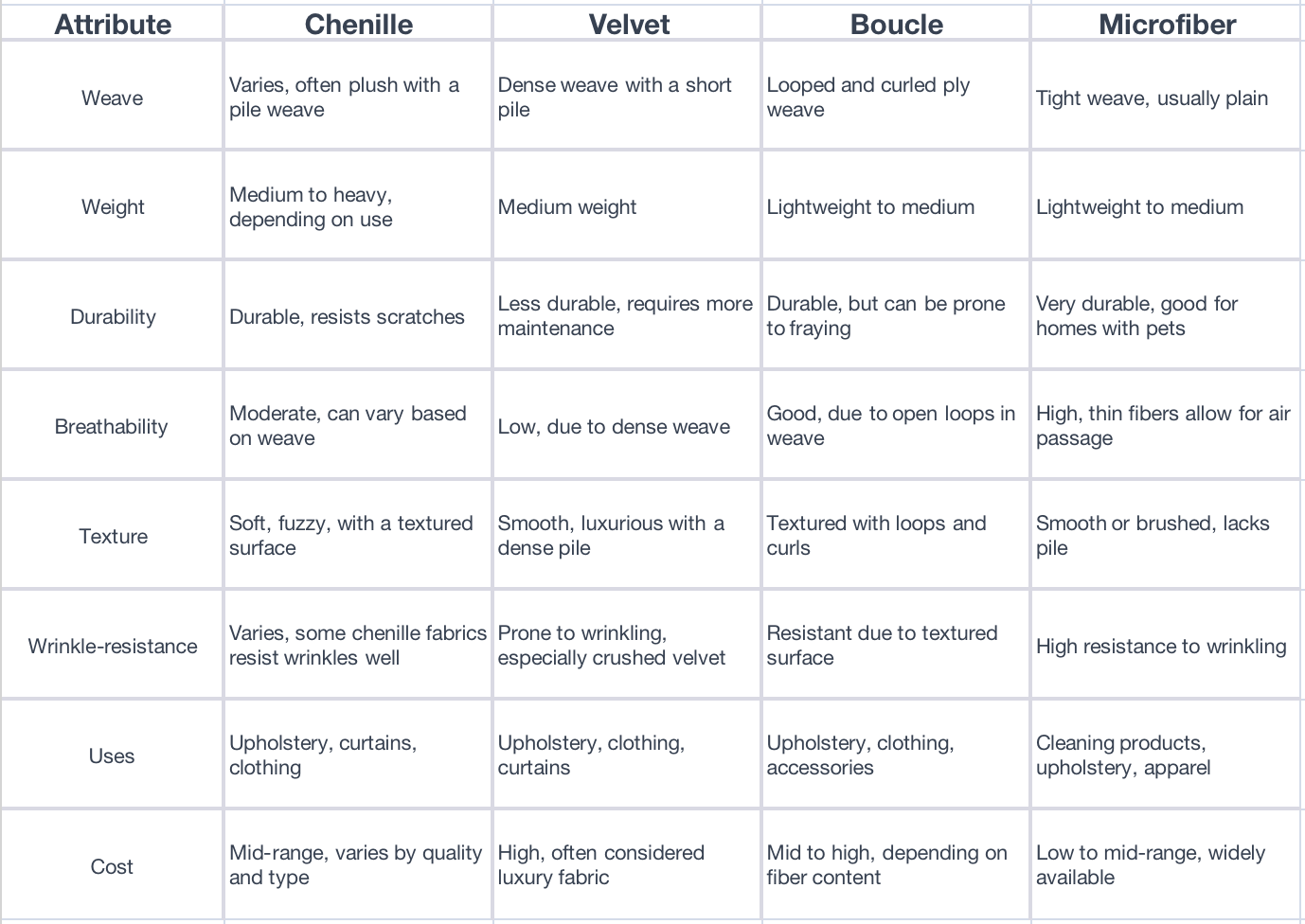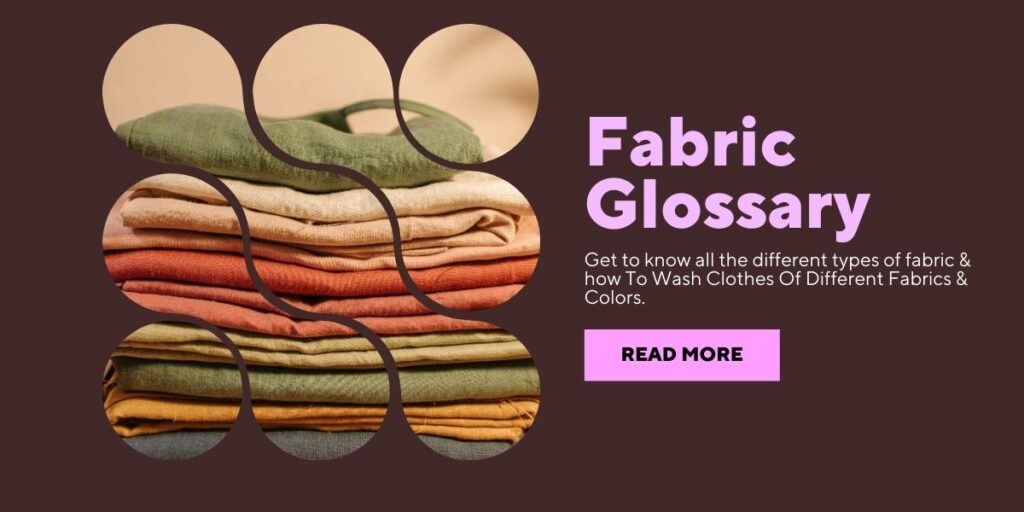Chenille Fabric Guide
A Detailed Guide to Chenille’s Features and Care
Chenille fabric, with its luxurious texture and versatility, dates back to the 18th century in France. The term ‘chenille’ means ‘caterpillar’ in French, which aptly describes the fabric’s soft, fuzzy feel. Designers and homeowners alike favor chenille for its unique aesthetic and comfort.
What is chenille?
Chenille fabric, known for its luxurious texture and versatility, has a rich history dating back to the 18th century. Originating in France, the word ‘chenille’ translates to ‘caterpillar’ in French, aptly describing the fabric’s soft, fuzzy feel. Today, chenille is a popular choice in fashion and home decor, celebrated for its unique aesthetics and comfort.
What Makes Chenille Unique
What sets chenille apart is its unique manufacturing process, where short lengths of yarn are wrapped around a core, creating its characteristic pile. The result is a fabric that’s not only visually appealing but also exceptionally soft to the touch. This section can delve into the specific qualities of chenille yarns and cotton chenille fabric, highlighting their distinct features.
Comparing Chenille: Velvet, Microfiber, and More
Chenille offers durability and ease of care that other fabrics like velvet and microfiber struggle to match. While velvet signifies luxury, chenille strikes a balance between luxury and practicality. These comparisons provide insights into “chenille vs velvet” and “chenille vs microfiber,” showcasing their suitability for different uses.
The Pros and Cons of Chenille Fabric
Durability and ease of care are qualities where chenille outshines other fabrics such as velvet and microfiber. Though velvet signifies luxury, chenille harmonizes luxury with practicality. Insights into “chenille vs velvet” and “chenille vs microfiber” emerge from these comparisons, showcasing their suitability for different applications.
Chenille vs Velvet
- Texture and Feel: Velvet has a short, dense pile, creating a smooth and luxurious surface. It absorbs light and appears denser compared to chenille, which has a fuzzy, textured surface with closed loops.
- Durability: Chenille is more scratch-resistant and durable than velvet. Velvet requires more maintenance to keep in good condition, while chenille is more robust and suitable for regular use.
- Appearance and Maintenance: Velvet offers a luxurious and elegant look with rich colors and patterns but is more demanding in terms of maintenance. Chenille, while also luxurious, is easier to maintain and more affordable.
Chenille vs Boucle
- Fabric Construction: Chenille is created by placing short lengths together between two strands of core yarn and plying it all together. This results in a soft texture that becomes even softer after washing.
- Fabric Quality: Chenille can have a tendency to “worm” if not woven tightly, causing loops to show in the weaving. In contrast, boucle yarn has loops and twirls in its construction, giving it a distinct texture.
- Uses and Adaptability: Both fabrics are suitable for towels and other home items, but their thickness and softness vary. Boucle may not be as thick as some prefer for bath towels, while chenille can be very soft and suitable for various applications
Chenille vs Microfiber
- Strength and Durability: Both chenille and microfiber are made from polyester fibers, offering similar durability and rub resistance. However, microfiber has a particularly thin fiber that is incredibly strong, making it a more suitable choice for pet and child-friendly homes.
- Flexibility and Maintenance: Microfiber has better flexibility than chenille and retains its shape better. Chenille tends to sag if not used with backing material for upholstery. Microfiber is superior in stain resistance and easier to clean compared to chenille, which has a textured finish that holds stains more.
- Piling and Surface Damage: Microfiber is less likely to show piling or pull compared to chenille. Chenille can show piling when raised fibers catch on something, and lower-density chenille is more prone to surface damage.
- Design Variety: Chenille offers a wide range of textures and patterns, allowing for more varied design options compared to microfiber, which is typically available in a smooth or brushed finish.
- Pet-Friendliness: Chenille hides pet hair well but can attract hair into its fluffy surface fibers. Microfiber repels pet hair better due to its tighter weave. Chenille’s raised fibers and textured loops may get damaged by pet claws, making microfiber a better choice for homes with pets.
- Durability: Known for its strength, making it a reliable choice for frequently used garments, in contrast to Linen’s moderate durability but high breathability.

Uses in Fashion and Decor
Chenille’s adaptability extends to fashion, where it’s used for cozy sweaters and elegant garments, and to home decor, as a preferred material for upholstery. The comfort and aesthetic appeal of chenille fabric sofas and couches contribute to their popularity.
Caring for Chenille: Best Practices
Maintaining the beauty of chenille is straightforward. This section offers tips on cleaning chenille couches and washing chenille blankets to preserve the fabric’s allure and ensure its longevity. It addresses common queries such as “how to iron on chenille patches.”
Chenille fabric’s unique blend of luxury, comfort, and versatility makes it a timeless choice for stylish garments and statement pieces in home decor.
FAQ
What is chenille made of ?
Chenille is a unique fabric known for its soft, fluffy texture with a pile on its surface, reminiscent of a caterpillar, which is what “chenille” means in French. The fabric can be made from various fibers, including:
- Silk
- Wool
- Cotton
- Rayon
- Synthetic fibers like polyester
What is chenille yarn?
Chenille yarn is a soft material that has a pile, making it appear bulky and cozy. It’s created by placing short lengths of pile yarn between two core yarns and then twisting them together. This process forms loops that are then cut to create the plush chenille texture we’re familiar with. Chenille yarn can be made from both natural and synthetic fibers, and it’s often used for knitting quick projects due to its bulkiness and warmth.
For the remaining FAQs, such as how to clean a chenille couch, how to wash a chenille blanket, how to iron on chenille patches, what chenille feels like, and whether chenille is soft, we’ll need to conduct further research to provide you with accurate answers. Would you like to continue with these questions?
How to clean chenille couch?
- Surface Cleaning: Use a soft bristled brush to gently remove surface dirt from the chenille couch. Circular motions can loosen dirt without damaging the fabric.
- Stain Removal: If there’s a stain, blot it with a cotton cloth. Avoid rubbing, as this can cause the stain to spread. Generally, water should not be used on chenille as it may ruin the material.
- Overall Cleaning: For overall cleaning, use a damp cloth to wipe the couch, avoiding saturation with water. Always test any cleaner on an inconspicuous area first.
- Shampooing: Consider using a suitable upholstery shampoo, following the instructions carefully to prevent damage.
How to wash chenille blanket?
- Spot Treatment: Clean spills immediately by dabbing gently with a dry towel to prevent absorption and staining.
- Machine Washing: If the blanket is machine washable, use cold or warm water for washing and low heat for drying to prevent shrinkage.
- Washing Options: Depending on the manufacturer’s instructions, you can choose to hand wash or machine wash the chenille blanket.
- Care and Maintenance: Wash your chenille blanket carefully to maintain its plushness
How to iron on chenille patches?
- Heat Press: If using a heat press, set it to the appropriate temperature, usually around 320°F for chenille patches.
- Iron Settings: Set the iron to the highest temperature and use protective gloves when handling. Prepare the surface where you’ll place the patch.
- Placement: Decide on the position of the patch carefully and place a piece of cotton cloth over the patch to protect it from burning.
- Ironing: Iron over the pressing cloth on top of the patch for 20 to 45 seconds, then iron on the reverse side to ensure the patch adheres well.
What does chenille feel like?
- Texture: Chenille fabric is plushy and very soft to the touch. It feels feathery, sometimes silky, and is more dimensional compared to velvet.
- Comfort: Chenille fabrics are comfortable and luxurious, making them a popular choice for garments and upholstery.
- Appearance: The fabric catches light, giving it a shiny, iridescent look. When cared for properly, chenille maintains its durability and softness
Is chenille fabric good for dogs?
- Comfort for Dogs: Chenille can be comfortable for dogs to sleep on due to its softness and warmth.
- Pet-Friendly Considerations: While chenille offers visual texture and softness which may be good for pet beds and clothing, it can be damaged by animal claws and may attract pet hair.
- Potential Risks: Its pile is made of tiny loops that can be destroyed by pets, and some dogs may be allergic to chenille fabric.
Is chenille soft?
Chenille is indeed soft to the touch, providing a comfortable feel, which is why it’s often used for cozy items like blankets and clothing

